Plant hallucinogens as magical medicines Understand article
Did witches once soar through the night sky on broomsticks? Or were they hallucinating after eating or touching certain plants? Angelika Börsch-Haubold explains how modern pharmacology helps us to understand the action of many toxic plants – some of which are still used in medicine.
“Were such things here as we do speak about?
Or have we eaten on the insane root
That takes the reason prisoner?”
Shakespeare, Macbeth I.iii
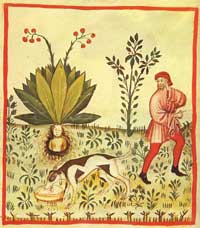
the mandrake root with the
help of a dog (Tacuinum
sanitatis, manuscript, 1390)
Public domain image; image
source: Wikimedia Commons
Thus wonders Banquo, who witnessed, together with Macbeth, the witches’ sabbath and the first foretelling of their future at the beginning of Shakespeare’s play. The apparitions were either true – or a hallucination. By giving these two options in 1606, at the height of the witch-hunt in Europe, Shakespeare not only provides a reasonable interpretation of the state of bewitchment, i.e. of delirious dreams, but also points to a possible cause of this insanity. There are poisonous plants that, upon contact or ingestion, cloud our mind and make us experience unreal sensations. As the deplorable persecution of witches tells us, most Europeans unfortunately lacked such botanical knowledge at that time
Plants of the family Solanaceae
The “insane root” may well have been mandrake (Mandragora officinarum), the most famous magic plant of the Mediterranean, sold at high prices in markets north of the Alps. Since the root can resemble a human body, mandrake was believed to contain a spirit that brings fortune and guards against evil those who own or carry the root. However, it was a dangerous business to dig up the plant, as it would issue a deadly shriek when taken from the earth. For this purpose, people were advised to fasten a dog to the half-exposed root and let the animal draw the plant out, a ritual that is often depicted in medieval books (left). Hundreds of years later, Goethe’s Mephistopheles makes fun of this superstition: “Da stehen sie umher und staunen, vertrauen nicht dem hohen Fund; der eine faselt von Alraunen, der andre von dem Schwarzen Hund.” (‘There they stand and marvel, not believing in the precious find; one drivels of mandrake, the other of the Black Dog.’ Goethe, Faust II, Act I).
Mandrake and other plants of the nightshade family (Solanaceae) contain alkaloids that block nerve impulses, which may lead to hallucinations. Although the cellular and molecular mechanism of action was only explained at the end of the 20th century, the pharmacological effects of these plants were already described by the Greco-Roman physicians Dioscurides (1st century AD) and Galenus (circa 129-199) and, from the 16th century onwards, by authors of herbal medicine books in local languages. The plants deadly nightshade (Atropa belladonna) and henbane (Hyoscyamus niger; below) are indigenous to middle and northern Europe and were therefore readily available for medicinal use or narcotic and poisonous abuse.
The physician Leonhart Fuchs explains in his New Kreüterbuch (printed in 1543) how to apply parts of these plants as sleeping agents and painkillers. In addition, he warns of their narcotic and toxic effects (see box). He also groups the plant thorn-apple (Datura stramonium; below), which had recently been brought to Europe by travellers from India or Mexico, botanically correctly with the nightshades, but admits his ignorance of its medicinal usage.
Witch ointments
If ever there were women experimenting with poisonous plants, and if ever they did anything other than use their knowledge to heal sick people who could not afford to (or maybe wisely choose not to) see a doctor, they may have used black or deadly nightshade and henbane as powerful ingredients in their medicines. Unfortunately, there are no direct sources for the recipes of witches’ concoctions. As is known from the literature condemning magic rituals, so-called ‘witch ointments’ were used to anoint a broomstick or a chair as a prerequisite for riding through the air and dancing at the witches’ sabbath (see box, image left). Such an ointment was reputedly given to the accused directly by the Devil or by an older woman who was already a member of the witches’ circle.
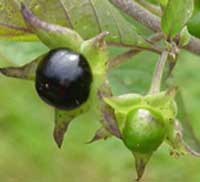
(Atropa belladonna)
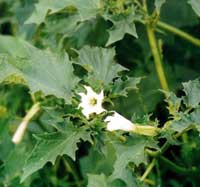
(Datura stramonium)
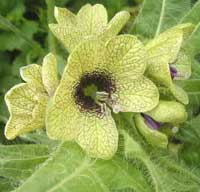
(Hyoscyamus niger)
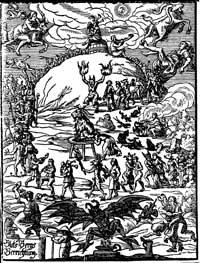
Sabbath (Blockes-Berges
Verrichtung), Leipzig, 1668
Public domain image; image
source: Wikimedia Commons
The recipes that have survived were written down by physicians. For example, Johannes Hartlieb, explaining the seven magic arts to the duke Johann of Brandenburg-Kulmbach in 1456, names six plants for the preparation of unguentum pharelis (see box). Although the plants were believed to possess magic powers, they are relatively harmless. Hartlieb had studied both theology and medicine, as was usual at the time, and the purpose of his writing is to prove that all witchcraft and magic is a lie. He therefore may have left out any narcotic ingredients on purpose.
Other physicians, however, most of them writing centuries later, name the plants of the family of nightshades along with the highly toxic wolfs-bane (Aconitum napellus), hemlock (Conium maculatum), and the sleep-inducing opium poppy (Papaver somniferum) as ingredients for witches’ medicines. They seem to have put together everything that was poisonous, and ethnologists of the 19th century, recreating witches’ ointments and applying them to their skin, indeed experienced disturbing hallucinations with all the side effects on the nervous system that a contemporary pharmacologist would expect.
Witches probably did not read the medical literature of their time, but we can safely assume that they knew of the hallucinogenic effects of the plants that grew in their neighbourhood. Henbane was already used by Germanic tribes to increase the intoxicating action of their ale. It was banned as an ingredient of beer in 1507/1516 in Bavaria, and after that its use in narcotic drinks was, at least in southern Germany, illegal. Deadly nightshade was also widely known. Its common name, ‘belladonna’, alludes to the practice of Italian Renaissance women who dilated their pupils with eye drops to make them look sexually attractive. If these women also ingested deadly nightshade, they would have experienced euphoria due to a stimulation of the central nervous system.
The pharmacology of nightshade plants
Today the action of deadly nightshade, henbane, and thorn-apple is understood in molecular detail. They all contain the alkaloids atropine and scopolamine, two closely related substances which interfere with the parasympathetic nervous system. Under parasympathetic stimulation, the heart-beat slows, smooth muscles (the involuntary muscles of inner organs) contract, digestion juices flow, and glands produce watery fluids (saliva, tears, bronchial mucous; Table 1). The neurotransmitter acetylcholine couples these nerve signals to the effector cells by activating muscarinic receptors, which in turn trigger changes within the cell that are related to the physiological response of the organ. For example, the intracellular Ca2+ concentration increases, which is necessary for muscle contraction and secretion.
Atropine and scopolamine chemically resemble the neurotransmitter acetylcholine. They also bind to muscarinic receptors but fail to stimulate the cell (i.e., act as antagonists). Thus, nerve transmission is blocked. Since acetylcholine is an important neurotransmitter in the brain as well, antagonism of muscarinic receptors also causes central effects. At low doses (0.5-1 mg), atropine leads to mild excitation, whereas scopolamine is responsible for drowsiness, fatigue, dreamless sleep and euphoria. The ingestion of higher doses causes restlessness and hallucinations. Poisoning with about 10 mg of atropine (less for children) leads to central depression of life functions, which may progress to coma, circulatory collapse and respiratory failure (Table 1).
| Organ | Acetylcholine | Atropine, Scopolamine |
|---|---|---|
| Eye | contraction of sphincter muscle;
contraction of ciliary muscle for near vision; + secretion by lacrimal glands |
dilation of pupils (mydriasis);
blurring of near vision (cycloplegia); dry eye |
| Heart | – heart rate; – contractility | + heart rate (tachycardia);
cardiac arrhythmias |
| Lung | contraction of tracheal and bronchial muscle;
+ secretion by bronchial glands (watery mucous) |
dialation of bronchioles;
– secretion: dry mucous membranes |
| Stomach Intestine |
+ tone and motility;
relaxation of sphincters; + secretion by digestive glands |
– motor activity;
– secretory function |
| Urinary bladder | contraction of muscles of the bladder wall;
relaxation of sphincter muscle |
difficulty in urination |
| Skin | + secretion by sweat glands | – sweat: skin flushed, hot, dry, and scarlet (body temperature +) |
| Mouth | + watery secretion of saliva | dry mouth, difficulties in swallowing, thirst |
| Brain | medulla and higher cerebral centres regulate the vagus nerve | restlessness and fatigue; headache; hallucinations, delirium, followed by coma, circulatory collapse, and respiratory failure |
Leonhart Fuchs’ New Kreüterbuch (new book of herbs), Basel 1543
About mandrake
…The apples as you sniff and taste them/ bring about the sleep. Such power has also their juice. But you shall not use too much/ because otherwise they kill…. Because the internal use of mandrake is very dangerous/ it is better to bring about the sleep/ if need be/ using the apples and fruits of it/ by just tasting them/ and not taking them into the body.
About nightshade
…The other one we named Maddening Herb [deadly nightshade]. Others call it Swine Herb/ and think it is the woody nightshade/ but not without great error/ as this herb is a deadly plant/ and cannot be ingested without harm/ as is possible with the woody nightshade. However, it might be the third sex of mandrake…. Without doubt the Maddening Herb has the power of the fourth nightshade/ which makes mad and foolish/ because it is a deadly herb for human/ as given by experience. I also know certainly of two children/ who have eaten the berries/ which taste quite sweet/ and they died soon thereafter/ although they had been lively and healthy before….
About henbane
Many call henbane also Swine Beans and Sleeping Herb…. Henbane ground freshly alone/ or mixed with malted barley and applied/ takes away all sorts of pains. The juice pressed from the herb/ a handkerchief wetted therein/ and put onto the hot/ running and painful eyes/ quenches the heat/ stops the flow and their pain. The juice or the seed oil put into the ears/ quenches the stinging therein/ and the pain. But use these with great care…. A foot bath made from henbane/ brings sleep…. The roots of Henbane boiled in vinegar and held in the mouth for some time/ takes away the great and bad aches of teeth. In summary/ the green Henbane leaves/ the seeds/ and juice/ which not only make man mad and foolish/ but also the beasts/ must not be used internally/ but only externally to stop the pain/ and to bring sleep/ and if used at all then only with good modesty.
Note: The original German text is available online.w1
Medical use of atropine and related drugs
Atropine, scopolamine and synthetic analogues are still used as medicines, mainly to inhibit the effects of the parasympathetic nervous system. In order to prevent disturbing side effects, either the substances are applied locally (eye drops for the examination of the retina, inhalation for respiratory diseases), or specific receptor blockers are developed (tablets blocking gastric acid secretion to treat peptic and duodenal ulcers; see box).
Blocking the action of acetylcholine also improves the motion disorder Parkinsons’ disease. However, since the introduction of more specific drugs acting on dopamine pathways, atropine derivatives are used only to treat early symptoms or as additional therapy.
The most important use of atropine today is as an antidote for poisoning by the alkaloid muscarine (present in certain mushrooms) or by organophosphate insecticides. Both substances overstimulate the parasympathetic system. To antagonise toxic effects, atropine is injected for up to 48 hours. The doctor monitors the patient closely, giving a new injection as soon as muscarinic symptoms reappear, but not too early so as to prevent atropine toxicity.
Trial protocol – witches’ ointment
Heinrich Kramer/Institoris, Malleus maleficarum, Strasbourg 1486, Ch. II(3)
The way of flying is the following: as became clear from above, the witches have to prepare a salve from the boiled limbs of children, especially from those whom they have murdered before baptism, and rub it onto any chair or piece of wood following the instructions by the demon, whereupon they immediately rise into the air…
Johannes Hartlieb, The book of all forbidden arts, Munich 1456, Ch. 32
How the riding through the air is accomplished. For these rides men and women, especially the demons, use a salve called ‘unguentum pharelis’. They prepare it from seven herbs, each of which is collected on the day belonging to the herb. On Sunday, they pick and dig Solsequium, on Monday Lunariam, on Tuesday Verbenam, on Wednesday Mercurialem, on Thursday Barbam Jovis, on Friday Capillos Veneris. They make the salve by mixing these with quite a lot of birds’ blood, and also animal lard. I do not write down details, so as to harm no one. Whenever they want to, they rub it on benches or chairs, rakes or oven forks and fly away. This is nothing but necromancy, which is strongly forbidden.
Classroom activity:
- Look up the plants that are mentioned in Hartlieb’s recipe in botany books, books on plant medicines and the Internet. What properties do they have? Solsequium (“following the sun”) could be either Heliotropium europaeum or one of the magical plants Calendula officinalis, Cichorium intybus or Taraxacum officinale. Barba Jovis is Sempervivum tectorum, and Capillus Veneris is probably the fern Adiantum capillus-veneris.
- Find out about plants of the family Solanaceae. Are they all poisonous? How do the properties of the Solanaceae family compare with those of the plants mentioned in Hartlieb’s recipe?
- What would you feel if you were to apply a witches’ ointment to your skin?
Note: The original German text is available online.w1
Effects and side effects of drugs that block the muscarinic receptor
For this exercise, you will need information about the effects and side effects of some anti-muscarinic drugs. Ask your local pharmacist to lend you the European Pharmacopoeia or to photocopy the customer information supplied with antimuscarinic drugs (see the list below for examples).
Your students should use this information to consider the effects and side effects of anti-muscarinic drugs. Are they due to the blocking of nerve transmission? Which effects are peripheral and which are central? Using the information in Table 1, students should be able to identify which effects and side effects of the drugs are caused by muscarinic receptor blockers.
Some examples of suitable answers include:
- Eye drops containing atropine, scopolamine, homatropine or tropicamide are used to dilate the pupils for the examination of the retina. Ocular side effects are photosensitivity and blurred vision.
- The specific muscarinic M1 receptor antagonist pirenzepine selectively inhibits gastric acid secretion and is used to treat gastric ulcers. However, it can cause a dry mouth, blurred vision, photophobia and difficulty in urination.
- Ipratropium bromide dilates the smooth muscles in the respiratory tract and alleviates symptoms in asthma. The atropine molecule is chemically changed to contain a charged residue. This prevents the substance from passing into the brain, and central side effects are missing. The local application by aerosol inhalation also helps to restrict unwanted effects.
- Benztropine or diphenhydramine are used against mild symptoms of Parkinson’s disease or as adjunct to the dopamine therapy of Parkinson’s disease. Adverse effects are constipation, urinary retention and blurred vision. In addition, sedation and mental confusion have been reported in the elderly.
- Scopolamine is highly effective for preventing motion sickness when used prophylactically. This is a central effect of the belladonna alkaloid. The drug is incorporated into a multilayered adhesive unit and put directly onto the skin. Common side effects are dry mouth, drowsiness and blurred vision. Psychotic episodes are very rare.
Conclusion
Today, we have difficulties understanding the deep, sincere belief in witchcraft and in the reality of magic that governed Europe for centuries. It is even more puzzling to realise that the heyday of witch-hunting happened in the 16th and 17th centuries, a time when the Sun was put in the centre of the universe and Renaissance artists drew muscular, naked human bodies right in the heart of the Vatican. Unfortunately, most of our scientist colleagues of 500 years ago did not speak up and solve the mysteries of night flights on broomsticks, although they – like Shakespeare – were almost certainly familiar with the hallucinogenic effects of some plants. But why did the ‘witches’ themselves not explain where their dreams came from? I suspect that very few of those who were accused, tortured and burnt had actually experienced hallucinations caused by toxic plants – or indeed by anything else. In the face of the estimated 60,000 victims in Europe, one could believe that the Devil himself had had a hand in it.
Web References
- w1 – The original German texts are available here
Resources
- Behringer W (2001) Hexen und Hexenprozesse in Deutschland. Munich, Germany: Deutscher Taschenbuch Verlag
- Fuchs L (1543) New Kreüterbuch. Basel, Switzerland: Durch M. Isingrin
- Hardman JG, Limbird LE, Goodman Gilman A (eds; 2001) Goodman & Gilman’s The Pharmacological Basis of Therapeutics, 10th Edition. New York, NY, USA: McGraw-Hill
- Hartlieb J (1989) Das Buch aller verbotenen Künste, translated by Eisermann F, Graf E. Ahlerstedt, Germany: Param
- Institoris H (1982) Malleus maleficarum, translated by Schmidt JWR. Munich, Germany: Deutscher Taschenbuch Verlag
- Scherf G (2002) Zauberpflanzen – Hexenkräuter. Munich, Germany: BLV
- Dr Angelika Börsch-Haubold, who is a trained pharmacist and pharmacologist, teaches regularly at the Fachhochschule Weihenstephan, Freising, Germany.
Review
People who think that teaching or learning science at school is boring would surely change their mind if they read this article. Angelika Börsch-Haubold takes us in on an exciting journey across English and German literature, history, botany, human physiology and bio-chemistry to explore facts and myths of witch medicine.
Even if the addressed subject is a specific one, the style of the article is engaging, clear and precise and the information provided is supported by a rich set of documents: quotations, original texts with translations, tables, pictures and literature references.
The article and the proposed classroom activities (on the quoted plants and on the side effects of anti-muscarinic drugs) are particularly suitable for upper secondary school but, with a little simplification, they can be adapted for lower secondary school within science and humanities curricula.
In fact the interdisciplinary approach is a relevant feature of this material and gives the possibility to extend the proposed activities to different fields (biology, chemistry, history) and to discuss relevant issues like the problem of drug abuse (health education). Finally the methodology used by the author can be applied to address other scientific subjects with a wider cultural approach, giving them a deeper meaning and an extra appeal.
So, if you need a special lesson for Halloween… keep this article to hand!
Giulia Realdon, Italy





